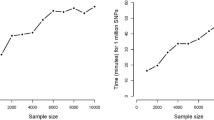Abstract
Parameter estimates obtained in the genetic analysis of longitudinal data can be used to construct individual genetic and environmental profiles across time. Such individual profiles enable the attribution of individual phenotypic change to changes in the underlying genetic or environmental processes and may lead to practical applications in genetic counseling and epidemiology. Simulations show that individual estimates of factor scores can be reliably obtained. Decomposition of univariate, and to a lesser extent of bivariate, phenotypic time series may yield estimates of independent individual G(t) and E(t), however, that are intercorrelated. The magnitude of these correlations depends somewhat on the autocorrelation structure of the underlying series, but to obtain completely independent estimates of genetic and environmental individual profiles, at least three measured indicators are needed at each point in time.
Similar content being viewed by others
References
Boomsma, D. I., and Molenaar, P. C. M. (1987). The genetic analysis of repeated measures. I. Simplex models.Behav. Genet. 17:111–123.
Boomsma, D. I., Martin, N. G., and Molenaar, P. C. M. (1989). Factor and simplex models for repeated measures: Application to two psychomotor measures of alcohol sensitivity in twins.Behav. Genet. 19:79–96.
Boomsma, D. I., Molenaar, P. C. M., and Orlebeke, J. F. (1990). Estimation of individual genetic and environmental factor scores.Genet. Epidemiol. 7:83–91.
Brown, R. G. (1983).Introduction to Random Signal Analysis and Kalman Filtering, John Wiley & Sons, New York.
Eaves, L. J., Hewitt, J. K., and Heath, A. C. (1988). The quantitative genetic study of human developmental change: A model and its limitations. In Weir, B. S., Eisen, E. J., Goodman, M. M., and Namkoong, G. (eds.),Proceedings of the Second International Conference on Quantitative Genetics, Sinauer Associates, Sunderland, Mass., pp. 297–311.
IMSL, Inc. (1979).IMSL Library Reference Manual Edition 7, IMSL, Houston, Tex.
Jöreskog, K. G., and Sörbom, D. (1988).LISREL VII, A Guide to the Program and Applications, Spss, Chicago.
Lawley, D. N., and Maxwell, A. E. (1971).Factor Analysis as a Statistical Method, Butterworths, London.
Martin, N. G., and Eaves, L. J. (1977). The genetical analysis of covariance structure.Heredity 38:79–95.
Priestley, M. B., and Subba Rao, T. (1975). The estimation of factor scores and Kalman filtering for discrete parameter stationary processes.Int. J. Control,21:971–975.
Author information
Authors and Affiliations
Rights and permissions
About this article
Cite this article
Boomsma, D.I., Molenaar, P.C.M. & Dolan, C.V. Estimation of individual genetic and environmental profiles in longitudinal designs. Behav Genet 21, 243–255 (1991). https://doi.org/10.1007/BF01065818
Received:
Accepted:
Issue Date:
DOI: https://doi.org/10.1007/BF01065818




